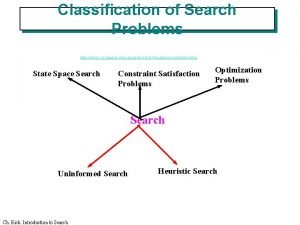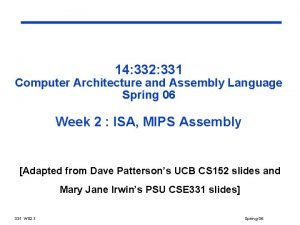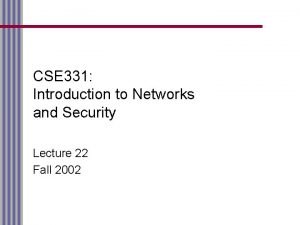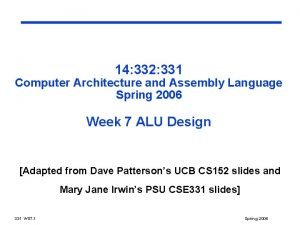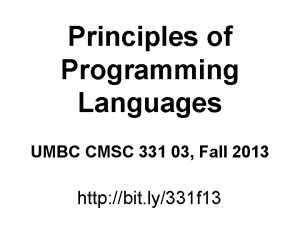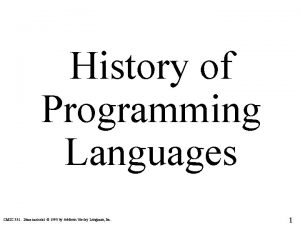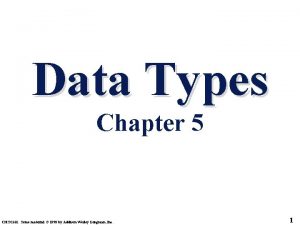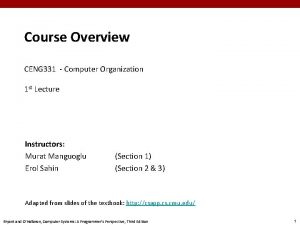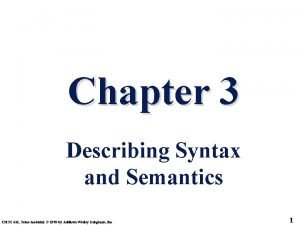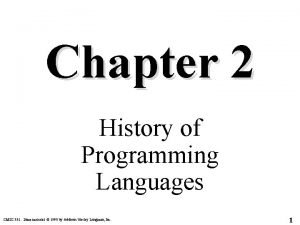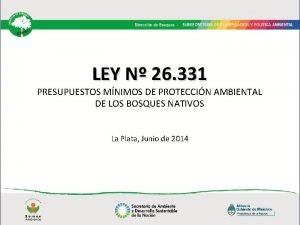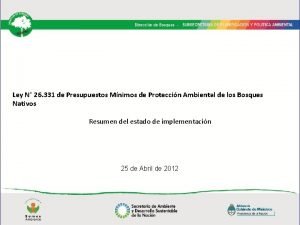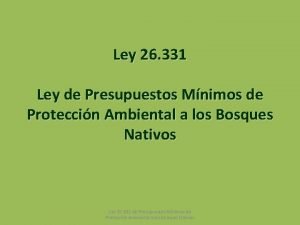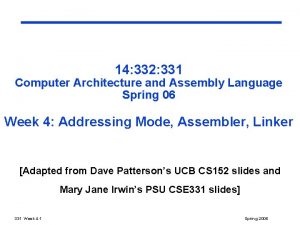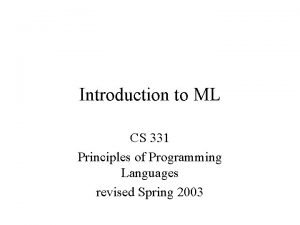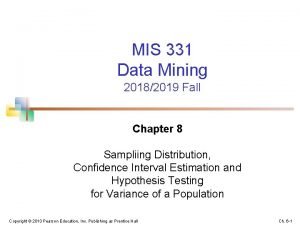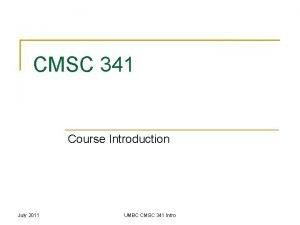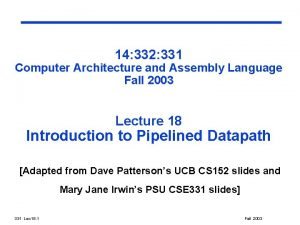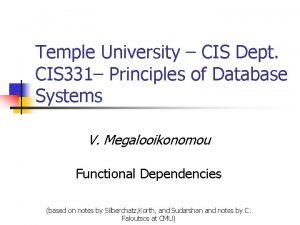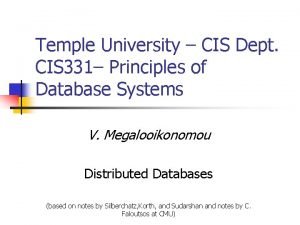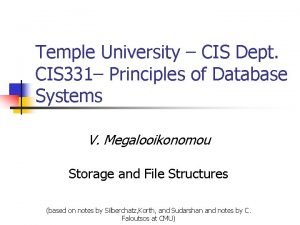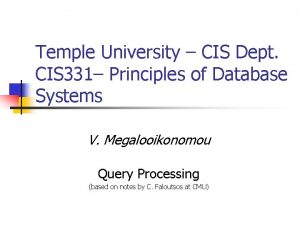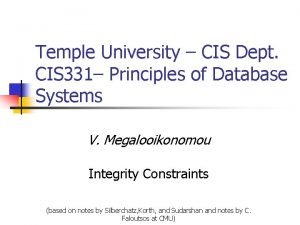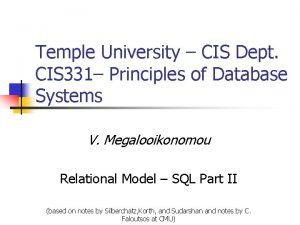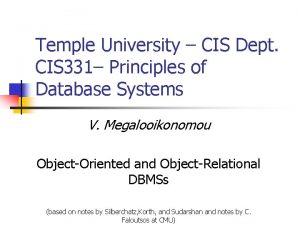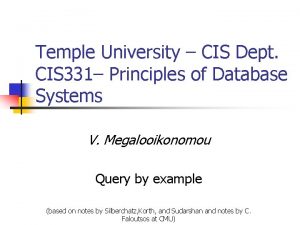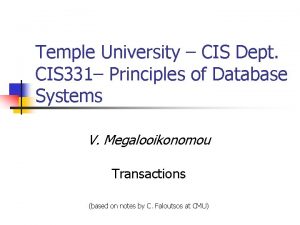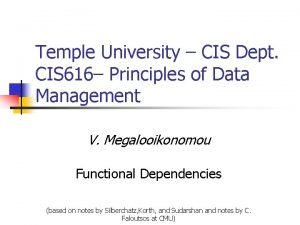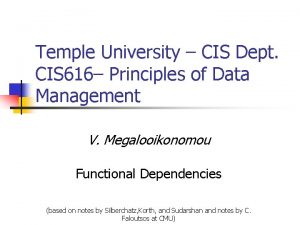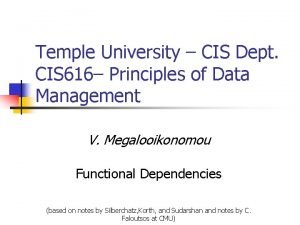Temple University CIS Dept CIS 331 Principles of


























































- Slides: 58

Temple University – CIS Dept. CIS 331– Principles of Database Systems V. Megalooikonomou Relational Model III (based on notes by Silberchatz, Korth, and Sudarshan and notes by C. Faloutsos at CMU)

Overview n n n history concepts Formal query languages n n n relational algebra rel. tuple calculus rel. domain calculus

General Overview - rel. model n n n history concepts Formal query languages n n n relational algebra rel. tuple calculus rel. domain calculus

Overview - detailed n rel. tuple calculus n n n why? details examples equivalence with rel. algebra more examples; ‘safety’ of expressions rel. domain calculus + QBE

Safety of expressions n FORBIDDEN: It has infinite output!! n Instead, always use

Safety of expressions n n n Possible to write tuple calculus expressions that generate infinite relations, e. g. , {t | t r } results in an infinite relation if the domain of any attribute of relation r is infinite To guard against the problem, we restrict the set of allowable expressions to safe expressions. An expression {t | P (t) } in the tuple relational calculus is safe if every component of t appears in one of the relations, tuples, or constants that appear in P

More examples: Banking example n n n branch (branch-name, branch-city, assets) customer (customer-name, customer-street, customer-city) account (account-number, branch-name, balance) loan (loan-number, branch-name, amount) depositor (customer-name, account-number) borrower (customer-name, loan-number)

Example Queries n n Find the loan-number, branch-name, and amount for loans of over $1200 {t | t loan t [amount] 1200} Find the loan number for each loan of an amount greater than $1200 {t | s loan (t [loan-number] = s [loan-number] s [amount] 1200} Notice that a relation on schema [loan-number] is implicitly defined by the query

Example Queries n n Find the names of all customers having a loan, an account, or both at the bank {t | s borrower(t[customer-name] = s[customer-name]) u depositor(t[customer-name] = u[customername]) Find the names of all customers who have a loan and an account at the bank {t | s borrower(t[customer-name] = s[customer-name]) u depositor(t[customer-name] = u[customername])

Example Queries n n Find the names of all customers having a loan at the Perryridge branch {t | s borrower(t[customer-name] = s[customer-name] u loan(u[branch-name] = “Perryridge” u[loan-number] = s[loan-number]))} Find the names of all customers who have a loan at the Perryridge branch, but no account at any branch of the bank {t | s borrower(t[customer-name] = s[customer-name] u loan(u[branch-name] = “Perryridge” u[loan-number] = s[loan-number])) not v depositor (v[customer-name] = t[customer-name]) }

Example Queries n Find the names of all customers having a loan from the Perryridge branch, and the cities they live in {t | s loan(s[branch-name] = “Perryridge” u borrower (u[loan-number] = s[loan-number] t [customer-name] = u[customer-name]) v customer (u[customer-name] = v[customer-name] t[customer-city] = v[customer-city])))}

Example Queries n Find the names of all customers who have an account at all branches located in Brooklyn: {t | c customer (t[customer. name] = c[customer-name]) s branch(s[branch-city] = “Brooklyn” u account ( s[branch-name] = u[branch-name] s depositor ( t[customer-name] = s[customer-name] s[account-number] = u[account-number] )) )}

General Overview n n relational model Formal query languages n n n relational algebra rel. tuple calculus rel. domain calculus

Overview - detailed n rel. tuple calculus n n dfn details equivalence to rel. algebra rel. domain calculus + QBE

Rel. domain calculus (RDC) n n Q: why? A: slightly easier than RTC, although equivalent - basis for QBE idea: domain variables (w/ F. O. L. ) – e. g. : ‘find STUDENT record with ssn=123’

Rel. Dom. Calculus n find STUDENT record with ssn=123’

Details n Like R. T. C - symbols allowed: n quantifiers

Details n but: domain (= column) variables, as opposed to tuple variables, e. g. : ssn name address

Domain Relational Calculus n n A nonprocedural query language equivalent in power to the tuple relational calculus Each query is an expression of the form: { x 1, x 2, …, xn | P (x 1, x 2, …, xn)} n n x 1, x 2, …, xn represent domain variables P represents a formula similar to that of the predicate calculus

Example queries n Find the branch-name, loan-number, and amount for loans of over $1200 n { l, b, a | l, b, a loan a > 1200} Find the names of all customers who have a loan of over $1200 n { c | l, b, a ( c, l borrower l, b, a loan a > 1200)} Find the names of all customers who have a loan from the Perryridge branch and the loan amount: { c, a | l ( c, l borrower b( l, b, a loan b = “Perryridge”))} or { c, a | l ( c, l borrower l, “Perryridge”, a loan)}

Example Queries n n Find the names of all customers having a loan, an account, or both at the Perryridge branch: { c | l ({ c, l borrower b, a ( l, b, a loan b = “Perryridge”)) a ( c, a depositor b, n ( a, b, n account b = “Perryridge”))} Find the names of all customers who have an account at all branches located in Brooklyn: { c | n ( c, s, n customer) x, y, z ( x, y, z branch y = “Brooklyn”) a, b ( x, y, z account c, a depositor)}

Reminder: our Mini-U db CLASS c-id c-name units cis 331 d. b. 2 cis 321 o. s. 2 TAKES SSN c-id 123 cis 331 234 cis 331 grade A B

Examples n find all student records RTC:

Examples n (selection) find student record with ssn=123

Examples n (selection) find student record with ssn=123 or RTC:

Examples n (projection) find name of student with ssn=123

Examples n (projection) find name of student with ssn=123 need to ‘restrict’ “a” RTC:

Examples cont’d n (union) get records of both PT and FT students RTC:

Examples cont’d n (union) get records of both PT and FT students

Examples n difference: find students that are not staff RTC:

Examples n difference: find students that are not staff

Cartesian product n n eg. , dog-breeding: MALE x FEMALE gives all possible couples x =

Cartesian product n find all the pairs of (male, female) RTC:

Cartesian product n find all the pairs of (male, female) RDC:

‘Proof’ of equivalence rel. algebra <-> rel. domain calculus <-> rel. tuple calculus n

Overview - detailed n rel. domain calculus n n n why? details examples equivalence with rel. algebra more examples; ‘safety’ of expressions

More examples n join: find names of students taking cis 351

Reminder: our Mini-U db

More examples n join: find names of students taking cis 351 - in RTC

More examples n join: find names of students taking cis 351 - in RDC

Sneak preview of QBE: TAKES SSN c-id grade _x cis 351

Sneak preview of QBE: n n n very user friendly heavily based on RDC very similar to MS Access interface TAKES SSN c-id grade _x cis 351

More examples n 3 -way join: find names of students taking a 2 -unit course - in RTC: join projection selection

Reminder: our Mini-U db _x . P _y 2 CLASS c-id c-name units cis 331 d. b. 2 cis 321 o. s. 2 TAKES SSN c-id 123 cis 331 234 cis 331 _x _y grade A B

More examples n 3 -way join: find names of students taking a 2 -unit course

More examples n 3 -way join: find names of students taking a 2 -unit course

Even more examples: n self -joins: find Tom’s grandparent(s)

Even more examples: n self -joins: find Tom’s grandparent(s)

Even more examples: n self -joins: find Tom’s grandparent(s)

Even more examples: n self -joins: find Tom’s grandparent(s)

Hard examples: DIVISION n find suppliers that shipped all the ABOMB parts

Hard examples: DIVISION n find suppliers that shipped all the ABOMB parts

Hard examples: DIVISION n find suppliers that shipped all the ABOMB parts

More on division n find students that take all the courses that ssn=123 does (and maybe even more)

More on division n find students that take all the courses that ssn=123 does (and maybe even more)

Safety of expressions n n similar to RTC FORBIDDEN:

Safety of Expressions { x 1, x 2, …, xn | P(x 1, x 2, …, xn)} is safe if all of the following hold: 1. All values that appear in tuples of the expression are values from dom a(P) (that is, the values appear either in P or in a tuple of a relation mentioned in P ) 2. For every “there exists” subformula of the form x (P 1(x)), the subformula is true if and only if there is a value x in dom (P 1) such that P 1(x) is true. 3. For every “for all” subformula of the form x (P 1 (x)), the subformula is true if and only if P 1(x) is true for all values x from dom (P 1).

Overview - detailed n rel. domain calculus + QBE n n n dfn details equivalence to rel. algebra
 Temple university cis
Temple university cis Cis 331
Cis 331 Cis temple
Cis temple Temple university entrepreneurship
Temple university entrepreneurship Temple university environmental engineering
Temple university environmental engineering Temple irb
Temple irb Temple disability services
Temple disability services Study abroad application temple
Study abroad application temple Temple university ielp
Temple university ielp Nsf cise msi
Nsf cise msi Isss temple university
Isss temple university Vraj temple philadelphia
Vraj temple philadelphia Map of consciousness
Map of consciousness Temple university change password
Temple university change password Temple university undergraduate bulletin
Temple university undergraduate bulletin Transportation planing
Transportation planing Ssis 331
Ssis 331 Uw cse 331
Uw cse 331 14:332:331
14:332:331 14:332:331
14:332:331 Affirmative easement
Affirmative easement Cse 331
Cse 331 Cse 332 p3
Cse 332 p3 Ist 331
Ist 331 Cmsc 331 umbc
Cmsc 331 umbc Cmsc 331
Cmsc 331 Ce 331
Ce 331 Ist 331
Ist 331 Cmsc 331
Cmsc 331 Cmsc 331
Cmsc 331 Cow metu
Cow metu Cmsc 331
Cmsc 331 Cmsc 331
Cmsc 331 In 331 bce, alexander the great successfully invaded egypt.
In 331 bce, alexander the great successfully invaded egypt. Ley 26 331
Ley 26 331 Ley 26 331
Ley 26 331 Ley 26 331
Ley 26 331 Komax 333
Komax 333 Pred-331
Pred-331 14:332:331
14:332:331 Ist 331
Ist 331 2011 plc (cs) 331
2011 plc (cs) 331 Anth 331
Anth 331 Mist-331
Mist-331 Cmsc 331
Cmsc 331 Umbc cmsc 341
Umbc cmsc 341 14:332:331
14:332:331 Dept nmr spectroscopy
Dept nmr spectroscopy Florida dept of agriculture and consumer services
Florida dept of agriculture and consumer services Organizational structure of finance department
Organizational structure of finance department Worcester inspectional services
Worcester inspectional services Dept. name of organization
Dept. name of organization Mn dept of education
Mn dept of education Ms department of finance and administration
Ms department of finance and administration Dept. name of organization (of affiliation)
Dept. name of organization (of affiliation) Ohio employment first
Ohio employment first Hjdkdkd
Hjdkdkd Vaginal dept
Vaginal dept Gome dept
Gome dept


